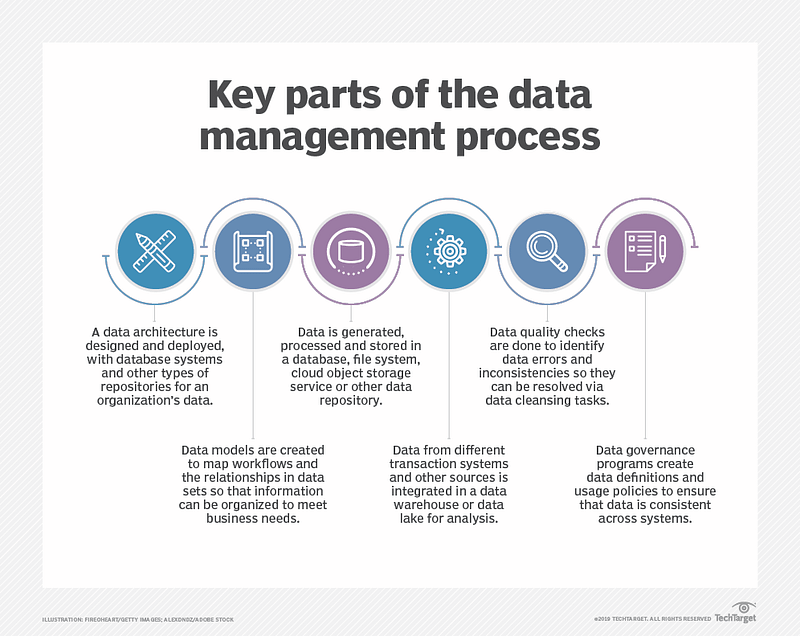Maximizing Data Potential Through Effective Management Strategies
Written on
Understanding Data Management
In today's digital landscape, organizations can swiftly gather extensive internal and external data from various sources. However, the sheer volume can lead to confusion over what is truly significant, potentially diminishing the data's value to the business. Therefore, disciplined data management is essential to optimize value, mitigate risks, and cut costs.
The Role of Data Management
Data management encompasses the systematic collection, organization, safeguarding, and storage of an organization's data to facilitate its analysis and application in business decision-making. Essentially, while Data Governance establishes the overarching policies for managing data, data management actualizes these guidelines. Without effective data management, governance becomes a mere set of theoretical rules that lacks practical application.

To effectively manage data, various methodologies are employed, including data modeling, integration, storage, and quality management. These practices ensure that data remains reliable, pertinent, and timely for its users.
- Data Modeling: Conceptually represents data objects and their interrelations.
- Data Integration: Merges disparate sources into a cohesive view.
- Data Storage: Secures and makes data accessible.
- Data Quality Management: Addresses data accuracy, completeness, and consistency.
Benefits and Challenges of Effective Data Management

To enhance data-driven decision-making, businesses must ensure that data is readily accessible to employees. Improved data visibility fosters greater organization and productivity. However, accessibility is futile if the data is not trustworthy. Through robust data management practices, organizations can minimize errors, establish trust in their data, and enhance overall decision-making processes.
Security: Implementing encryption and authentication measures can prevent data loss, theft, and breaches. These security protocols also ensure that crucial company information is backed up and retrievable in case of emergencies.
Scalability: Efficient data management allows organizations to scale their operations by establishing repeatable processes that keep data current and relevant. This reduces redundant costs associated with repeated queries or unnecessary research.
Best Practices for Data Management

To facilitate a seamless implementation of data management, organizations should adopt the following best practices:
- Establish Clear Governance Policies: Define how data should be collected, stored, and utilized, along with a responsibility matrix.
- Create Naming and Cataloging Standards: Develop a consistent system for naming and structuring files, making data easy to locate.
- Simplify Data Access: Provide tools that enable quick searches and retrieval of data from multiple sources.
- Implement Data Quality Standards: Monitor and report on data quality to ensure accuracy and consistency.
- Develop a Data Architecture Plan: Outline how data will be stored, managed, and accessed, including technology selection and schema design.
- Adopt a Data Catalog: Maintain a centralized inventory of data assets, facilitating user searches and data lineage tracking.
- Implement Security Measures: Protect data from unauthorized access through encryption and access control protocols.
- Set Data Retention Policies: Define how long data should be retained and when it should be disposed of, ensuring compliance with regulations.
- Create Backup and Recovery Plans: Regularly back up data and test recovery processes to mitigate data loss risks.
- Cultivate a Data-Driven Culture: Encourage data-oriented decision-making and provide training to enhance data literacy among employees.
- Monitor and Improve Data Processes: Continuously evaluate and optimize data management practices.
Getting Started with Data Management

Begin by identifying your objectives with data management. Determine what you aim to achieve and what data-related challenges you wish to address.
Next, compile a comprehensive list of all data assets within your organization, including databases, files, and applications, along with their usage and storage locations.
Afterward, classify your data according to its sensitivity and importance, allowing you to prioritize management efforts. Once you have established your critical path, outline a data governance framework that includes relevant policies and procedures.
To ensure effective management, appoint a dedicated team of data stewards, analysts, architects, and IT professionals who can collaborate on maintaining data integrity. Implement data validation and cleansing controls to catch errors early on.
Data security is paramount; establish measures to prevent unauthorized access, such as encryption and monitoring.
Finally, train employees on the importance of data management and how to effectively utilize the tools provided. Ongoing monitoring and improvement of data management processes are essential to align with your organizational goals.
For a deeper exploration of Data Governance and related topics, feel free to leave your comments below! Thank you for engaging with this content, and have a great day!

References
Unlock Your Business Potential: The Costly Consequence of Data Redundancy - YouTube
Discover the implications of data redundancy in your organization and learn how to avoid costly errors in data management.
Data Governance Fundamentals - Nicola Askham - YouTube
Gain insights into the fundamentals of data governance and how it plays a critical role in effective data management.